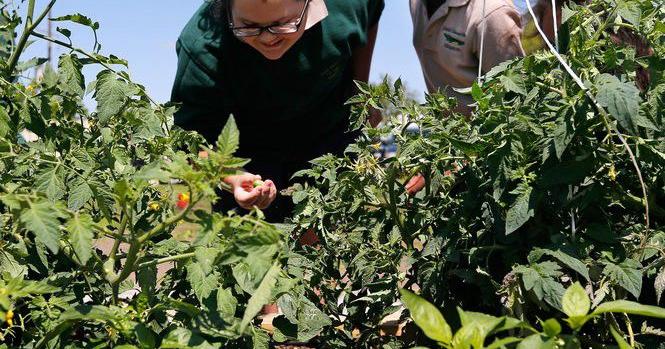There seems to be something in the air this time of the year that brings out the vegetable gardener in all of us. Every spring, new gardeners discover growing their own food. And veteran gardeners look forward to another season of fresh vegetables.
I’ve never seen vegetable gardening more popular than it is now.
Mid-March to mid-April is one of the most active times of the year for vegetable planting.
So much information on vegetable gardening is available that it can be bewildering. Advice from staff at the nursery, friends, family, books, publications and, especially, the internet may leave you feeling bombarded by various, and even contradictory, recommendations.
It seems needlessly confusing. Surely there is a best, surefire way to successfully grow a garden.
But there isn’t. The sooner you understand that the better you will be able to sift through the plethora of information and find what works for you. Take a deep breath and decide which ways best fit what you are trying to accomplish.
Planting early helps tomatoes stay healthy through their growing period.
MCT / Norman Winter
Gardening is like cooking. Expecting there to be just one way to prepare a bed for planting is like expecting there to be just one way to make a great gumbo. The basic techniques of cooking a gumbo (the vegetable “trinity,” the protein and the roux) provide a foundation upon which to work — just like the basic techniques of vegetable gardening are there to help ensure consistent success.
But whether cooking or gardening, beyond the basic techniques, there is ample room for creativity and variations that result in successful outcomes.
Above all, be sure the information you are using is appropriate for southeast Louisiana. Vegetable planting schedules vary from one region to the next. Even some gardening techniques can be different.
The LSU AgCenter has vegetable garden publications written specifically for Louisiana available online. You can access LSU AgCenter information through online searches. Use “LSU AgCenter home vegetable gardening” to see the broadest listing. You could also search for specific vegetable information, such as “LSU AgCenter tomatoes” or pest control, such as “LSU AgCenter vegetable insect control” or “LSU AgCenter vegetable disease control.”
Vegetables can be grown in raised garden beds like these. The size and shape make them easy to access.
STAFF PHOTO BY BILL FEIG
Know the basics
BEDS: In southeast Louisiana, we plant vegetables in raised rows or raised beds due to the high level of rainfall. Much of the rest of the country does not do that.
Be sure your rows or raised beds are at least 8 to 12 inches higher than the surrounding soil. You can also grow vegetables in large containers.
BED PREP: Proper bed preparation is very important. If building raised beds, fill them with quality topsoil or garden soil mixes. In-ground beds should be generously amended with organic matter before planting.
Nothing beats good, homemade compost when preparing beds. But you can also purchase bagged compost, manure and soil conditioner. Generally, a 2- to 4-inch layer of organic matter is dug into the upper 8 inches of soil in the bed during preparation.
Spring planting of warm-season vegetables — tomatoes, snap beans, bell peppers, squash and cucumbers — begins in March.
JENNIFER ZDON
FERTILIZING: Doing this properly is important to abundant harvests. There is no one best fertilizer for a particular vegetable, or for vegetables in general. You do not need different fertilizers for each of the different vegetables you grow.
Generally, if your soil is high in phosphorous, use a fertilizer with a lower middle number, like 15-5-10, 16-4-8 or anything similar. If your soil is low in phosphorous, choose a more evenly balanced fertilizer like 8-8-8.
You may also rely on organic sources of mineral nutrients, such as compost, manure, alfalfa meal, blood meal, bone meal, fish emulsion or blended organic fertilizers. Sidedress with a nitrogen fertilizer four to six weeks after planting (except for legumes like snap beans, yardlong beans and edible soybeans)
KNOW YOUR SOIL: A soil test is the best way to determine what mineral nutrients may need to be added to the soil. A soil test is also important in determining the need to add lime. Contact your parish LSU AgCenter Extension office for information on getting your soil tested or go www.lsuagcenter.com/soiltest.
TIMING IS IMPORTANT: Planting vegetables at the optimal time can make the difference between success and failure. For example, tomatoes, bell peppers and snap beans set flowers best when temperatures are in the 70s and 80s during the day. As daytime temperatures move up into the 90s, fruit set is greatly reduced.
Know which pests you’re fighting. This leaffooted bug is widespread and a pest of many crops including fruits, vegetables, grains, nuts and ornamentals.
PHOTO BY RAJ SINGH
You can see why these crops are best planted from mid-March to late April. Waiting to plant in May means that most of the blooming will be done when temperatures are too high for good production. For complete information on when to plant vegetables, do an internet search for “LSU AgCenter Vegetable Planting Guide.”
HANDLING PESTS: When it comes to pest control, there are so many sources of information. This topic can be particularly confusing. First, know what pest you are dealing with. Get the insect or disease identified before deciding what to do (contact your parish LSU AgCenter extension office for diagnostic help).
Then look at a variety of effective options with an eye toward utilizing organic and/or chemical pesticides safely and minimizing environmental impacts. Make it a policy to minimize the use of pesticides, but the judicious application of pesticides can make the difference between success and failure.
The basis of vegetable gardening successfully here involves learning how to grow vegetables in our unique climate. Above all, enjoy yourself.

